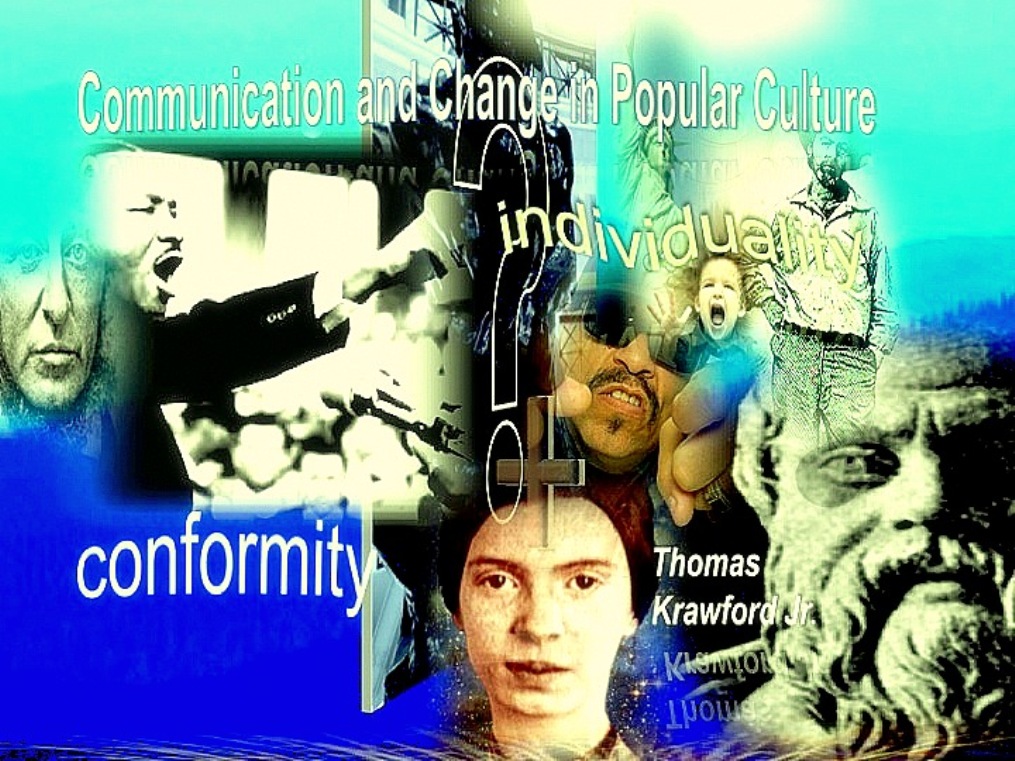Three Faces of Earth: Representations of Communal Diversity in Linda Hogan's
Mean Spirit
In Linda Hogan's Mean Spirit, three representations of diversity interact to interrogate the Eurocentric ideal of Manifest Destiny regarding Native and Non-white Americans in the badlands of Oklahoma during the time of the story. The first two "faces" constitute two specific channels of opposing power (Foucault 205). There is the face of joint communal diversity characterized by the Earth Spirit, and illustrated by Belle Graycloud's stand at Sorrow Cave. There is the "mean spirit" face of mostly white men who seek to invert the Earth Spirit with the violence of their ideology. The third "face" is that of the Cold Spirit of indifference; the general channels of power, such as the status quo of arranged marriages, land auctions and Christianity (205a). Overall, these three opposing faces of diversity as depicted in the novel in particular, may have implications for Native and African American contemporary experiences in general. In other words, the three faces of Earth as represented in Mean Spirit, are in many respects, the three faces of human society.
Kathryn Shanley (1999), would suggest that on the surface, ethnic minority writing regarding American racism, has often overlooked the struggles of Native American people. Consequently, the power of multicultural criticism to articulate a unified voice against systematic oppression detracts from itself because it does not do enough to centralize the interconnectedness of all oppressed peoples in its overall
framework (33). However, in Linda Hogan's Mean Spirit, that interconnectedness of oppressed people extends to include the oppressor, the oppressed and the indifferent in a competition of interests. In this way, the novel reflects the nature of contemporary culture. For instance, in the story, the perspective of privilege as defined by language divorced from a sense of the Earth, often conflicts with the everyday perspective of those who acknowledge the Earth as their identity (Foucault 204; Rainwater 3; Brice 3). This oppositional dichotomy illustrates itself throughout the text. On the one hand, there is the language of privilege which defines Indians as incompetent children without a nickel's worth of intelligence (Hogan 61). On the other hand, this theme converges into the concept of Manifest Destiny expressed through the testimony of Mardy, a henchman of the main antagonist, John Hale.
He simplified the war against the dark skinned people: they were
in the way of progress. Everyone needed the land, the oil, the…
grass, and the water. And all was fair, he told them. "We have
to go on as a race…They shoot dear don't they? Well here…it's
just survival." (327).
In this case, Linda Hogan's characterization of "entitlement" based on the language of race is evident. In addition, that sense of entitlement supports a language that redefines and justifies murder and thievery by calling it survival. Furthermore, the author extends this illustration to a multicultural level by stating through her character's eyes, how Manifest Destiny simplified the war against "dark skinned people" (327a). On the surface, the author refers to a Native American context. However, when Hogan describes an incident in Guthrie, Oklahoma, where Lettie Graycloud is given a room by a hotel clerk while Stace Red Hawk is turned away because he is too dark (346), there appears to be a deeper, more multicultural implication. A possible response then to Kathryn Shanley's argument (Shanley 33-35), is that the world Linda Hogan creates in Mean Spirit does in fact suggest the language of a functional public knowledge that is Native and Multiculturally American. In addition, although language supports a sense of entitlement that justifies murder by renaming it survival, Hogan uses the language of resistance to oppose that entitlement. Moreover, she situates that resistance in a context where its effect is strongest; namely, Belle Graycloud's Stand at Sorrow Cave.
Jennifer Brice points out that Belle Graycloud's stand at Sorrow Cave is like a transformation where her body and spirit merge with the spirit of the Earth as she defies the will of Jess Gold and the men who want to kill the Bats within (8). Linda Hogan would not dispute that observation, however, as Belle defies the sheriff, Hogan describes how, not only the Hill People, but Joe and Martha Billy, Father Dunne, Stace Red Hawk and Jim Josh, all stood with her, and so did Deputy Willis (280). On the one hand, Belle succeeded in standing up to the sheriff. On the other hand, Hogan implies that Belle's stand, like a mountain with a raven crown (279), represented the multicultural face of the community that stood beside her.
This image of a unified diversity is powerful and Hogan repeatedly challenges her suggestion of multicultural cooperation with scenes depicting the divisiveness of racism, an inverse diversity. An illustration of how the author uses these two opposing faces of diversity as opposing positions of power without either canceling out the other starts on page 293 of Mean Spirit.
The scene starts as a July 4th picnic. The Indians and the whites are sitting apart from one another. Right away, the overriding atmosphere of segregation would make this scene an illustration of inverse diversity. However, Sam Lee, who runs a foot race between the Indians and the whites complicates the illustration, while later, the barriers between Indian, white and Non-white are made even more ambiguous.
When the band returned from their break, the atmosphere loosened up.
Sam Lee, the Chinese runner, danced with an Indian woman who hardly
moved at all. An Indian man did the Charleston with a scrawny black woman
in a pea green hat. A white woman danced with an Indian man and looked
into his eyes as though he were the tree of knowledge itself, holding up the
noisy night sky above them (Hogan 297).
This is one example in the story where the opposing faces of diversity, joint and inverse,
meet in a place that is almost outside the time of Oklahoma in 1923. In this instance, as Indian, white, black and Chinese men and women dance together, the ground they finally have in common, if only for a brief moment, to paraphrase Jennifer Brice, arises from an experience of dispossession (1). Hogan implies a multicultural subtext in this case. However, she also implies that Sam Lee, the scrawny black woman with the pea green hat and the rest of the non-white/non-native Americans, although dispossessed as neither white nor Indian, represent the general elements of the townsfolk; a town that calls itself Watona, on the one hand, and Talbert, on the other. This distinction is important because it suggests two types of dispossession at work in the story: one that ultimately leads to resistance and one that leads to assimilation. Linda Hogan pairs these two versions of dispossession in much the same way the faces of diversity oppose each other at the 4th of July picnic: like a dance or a race.
Hogan does not dispute Brice's assertion regarding dispossession, but in
Mean Spirit, the subversive face of diversity becomes the face of Belle Graycloud just as the face of an inverse diversity becomes that of John Hale. The cold face of indifference and non-productive assimilation, however, is the face of the townspeople, which the author Hogan suggests is multicultural and working class. Subsequently, the contexts in which they interweave throughout the story, indicate her subtle criticism of the townspeople's lack of engagement in social justice. Yet, as a face of Earth, Hogan is also saying that the arranged marriages, land auctions, carnivals and Christianity of the status quo, represent a general power which mediates the space between communal and inverse diversities (Foucault 207; Hogan). In this regard, the three faces of earth are the social structure of human society in Mean Spirit. On the other hand, superseding this interpretation, Linda Hogan's novel is nonetheless, about the survival of a Native America who draws his and her strength from the Earth in a political act of resistance as survival in direct opposition to its inverse (Brice; Hogan; Rainwater; Shanley).
In the final scene as Stace Red Cloud leaves Levee and accompanies the Grayclouds from the burning wreckage of their place in the white world, political wisdom as a return to the Earth in this case is a return to identity (Shanley 33). However, the final scene is also a critique of the general status quo, which, on the one hand supports the overall social structure, yet remains mute on matters of social justice or responsibility
This is ironic because both American realities have a history of marginalization based on similar inversions of their cultural identities. Black people caught in Africa and brought to Jamestown, lost their families repeatedly in much the same way as Native Americans lost their land and self-respect.
If Multicultural discourse is a body of criticism that seeks to liberate the meaning of American Heritage from history, I believe the interconnectedness of all the historically marginalized, needs to figure more prominent in that discourse. I feel the perspective of social justice for all does not exist enough in contemporary Multicultural America and if Mean Spirit is any indication, I maintain, it is high time that it should.
Works Cited
Brice, Jennifer. "Earth as Mother, Earth as Other in Novels by Silko and Hogan." Critique (Atlanta Ga.) 39 (1998): 127-38.
Foucault, Michel. "Panopticism." Trans. Alan Sheridan. Discipline and Punish:The Birth of the Prison. Surveiller et Punir: Naissance de la prison. Second ed. New York: Vintage Books Random House, 1995. 195-228. Gallimard 1975.
Hogan, Linda. Mean Spirit. New York: Ballantine/Del Rey/ Fawcett/ Ivy. Division of Random House, 1990.
Rainwater, Catharine. "Intertextual Twins and Their Relations: Linda Hogan's Mean Spirit and Solar Storms." Modern Fiction Studies 45.1 (1999): 93-113.
Shanley, Kathryn W. "Talking to the Animals and Taking out the Trash: The Functions of American Indian Literature." Wicazo Sa Review 1.2 (1999): 32-45.


+of+IMG_9264.jpg)




